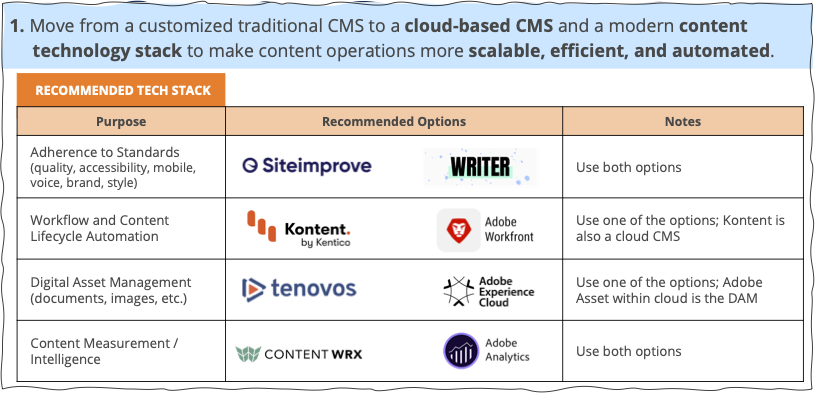
If you checked our latest Content Technology Infographic, you might have noticed more than 50 new tools in the mix. You also might have seen more subcategories. Many more, in fact. That’s because content technology trends are changing–and I’m optimistic that they are changing in ways that can be very useful to all of us as we mature content operations.
We’re tracking the landscape of content technology to highlight more of its nuance and its innovation as you consider your options. Forrester and Gartner tend to put content technology into broad, and sometimes odd, categories. In my experience, their models favor more established products that can afford the resources to engage and educate Forrester and Gartner analysts. I like how the Marketing Technology Landscape infographic includes innovative products, but its marketing focus doesn’t always address content for the entire customer experience. So, our goal with the Content Technology Landscape infographic and this article is to make considering your options easier. On to the top content technology trends …
1. More Content Tools Than Ever Use + Report Data
I’m perhaps most excited about this trend. Products that you wouldn’t typically associate with data analysis are starting to collect, integrate, or report data. For example, Acrolinx has always analyzed large volumes of content for adherence to style and standards and, based on that, provided writing assistance. Now, Acrolinx can connect your content to analytics, ContentWRX data, or other data and show the correlation between adhering to style and standards and effectiveness, performance, or other goals important to you.
As another example, the digital asset management system (DAM) Tenovos collects a variety of data about the distribution and display of specific assets such as images, PDFs, and video. This granular data provides a different view of your content assets’ impact.
This trend has many implications, and I’ll touch on one. Companies will need to gather more content data from more places and make sense of it. We call this establishing a system of content intelligence, and we find it also helps to set up a center of content excellence. The headless subcategory of CMS is maturing quickly. When I served as head of content for Mailchimp, we were early adopters of headless (specifically Contentful). If I said “headless,” most people cocked their head to the side like curious puppies. That’s not the reaction I’d get today. The vast majority of marketers at least know the term today. Martin Michalik of the headless CMS Kontent.ai explains that shift and more about the market change in this brief presentation. The number of headless options in our infographic hit 4 this year. So, it’s not surprising we have subcategories of this subcategory emerging. Products such as dotCMS consider themselves to be a hybrid, striving to bring together the best of headless and traditional CMS into one effective product. Sanity prefers calling itself a structured content platform, which goes further in the W3 direction of modeling content like data to enable sophisticated reuse and personalization. That might sound a little insane for a conglomerate like AT&T to try at scale. But try..and succeed…AT&T did. (Learn more in this conversation with Scott Gentz.) I’m only scratching the surface of the nuances here. And that brings us to our next trend on our content technology trends list. Every organization today needs efficient and scalable content operations. More tools are trying to address that need. Mailchimp, for example, enables planning and publishing not only emails but also social posts and small websites. As a very different example, Kontent.ai has surprisingly robust workflow capabilities, enabling you to tie different workflows to different content types. And as yet another very different example, tools like Conscia.ai are emerging to enable marketers to orchestrate just about any experience using multiple platforms. Such tools are emerging with a new philosophy. Rather than force a company to use one content or marketing platform for everything, a company should be able to use the “best of breed” tools relevant to their needs. And to do so easily. This philosophy is consistent with one of the success factors we discovered in our content operations research. More than 40% of organizations who reported content success used specialized tools in addition to a CMS. One implication of this trend is that you might be able to use a different combination of content technology now. For instance, if you decide to adopt Kontent.ai, you might find its workflow capabilities to be good enough that you can reduce or eliminate the use of a separate workflow tool. And that might free your resources to try a different tool to fill a different need. For instance, we recommended not simply a new CMS but an updated content technology stack to a global health conglomerate to achieve their content goals for employee communications. Last and definitely not least, artificial intelligence is living up to its potential for content. You might have noticed more product names ending in .ai. You also might have heard buzz about ChatGPT generating pretty good text for emails, chat responses, and more. Or you might have tried it yourself, since anyone can. That’s great, but we’re more excited about the way existing content tools are integrating artificial intelligence in immediately practical ways for content generation and more at growing businesses and organizations. These tools can accelerate creating content at a high level of quality. I think of it as these tools take you to 80% complete, leaving you with about 20% to do…usually final polishing or refinement. A few highlights…again, I’m only hitting the tip of the iceberg. One implication of this trend is if your company already took the time to define content standards and establish content governance, you’ll be able to adopt useful AI tools much faster than if you hadn’t. Nice! So, it’s an exciting time for content technology. The Content Science team and I will watch these content technology trends and more through the coming year, and I have no doubt we’ll see new ones emerge. If you’re considering changing your content technology stack, be sure to check out these resources:2. Headless CMS Options Are Proliferating
3. More Tools Address Content Ops Like Composability + Calendars + Workflow

4. Artificial Intelligence Is Content Help, Not Hype
If your company already took the time to define content standards and establish content governance, you’ll be able to adopt useful AI tools much faster.
-
Events, Resources, + More
The Ultimate Guide to End-to-End Content
Discover why + how an end-to-end approach is critical in the age of AI with this comprehensive white paper.
The Content Advantage Book
The much-anticipated third edition of the highly rated book by Colleen Jones is available at book retailers worldwide. Learn more!
20 Signs of a Content Problem in a High-Stakes Initiative
Use this white paper to diagnose the problem so you can achieve the right solution faster.
Upskill with Content Science Academy
Training for modern content roles through on-demand certifications + courses or live workshops.






Comments
We invite you to share your perspective in a constructive way. To comment, please sign in or register. Our moderating team will review all comments and may edit them for clarity. Our team also may delete comments that are off-topic or disrespectful. All postings become the property of
Content Science Review.